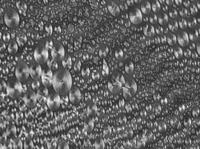Langmuir-Blodgett film

So imagine you have a toy box full of different kinds of toys, like Legos, blocks, and cars. And you want to organize them by putting them in neat, straight lines. That's kind of what a Langmuir-Blodgett film does, but with really, really tiny things called molecules.
You see, these molecules are like the building blocks of everything around you, even the air you breathe! And sometimes when scientists want to study them, they need to line them up in a specific way to see how they behave. That's where the Langmuir-Blodgett film comes in.
First, they take a plate or a surface and put water on it. Then they add the molecules they want to study to the water. The molecules will float around and stick to the water's surface like a raft. But they're not organized yet.
Next, they use a tool called the Langmuir trough (which is like a big flat pan with a handle) to push the molecules around and make them line up in a neat layer at the top of the water. This is called a monolayer, which means it's a layer of just one molecule thick.
But that's not enough. The scientists want to study how these molecules behave when they're all lined up and stuck together in a thin film. So they take another surface--usually a solid plate--and dip it into the water, touching it gently to the top of the monolayer. What happens is really cool: the molecules on the water's surface will stick to the plate and form a neat, flexible film on top of it.
But wait! The film is still only one molecule thick. How can we make it thicker so we can study it better? That's where the Blodgett part comes in. After the first plate is coated with the monolayer film, it's lifted out of the water and dried off. Then, it's lowered back into the water and lifted up again, this time sticking to more of the molecules on the surface. The process of dipping and lifting is repeated over and over until the film is as thick as the scientists want it to be--maybe 10, 20, or even 50 layers thick!
Now that they have their Langmuir-Blodgett film, the scientists can study how the molecules behave in this specific arrangement. They can see how they stick together, how they interact with light or electricity, or how they change when they come into contact with other substances. It's like they built a tiny "toy box" for the molecules to play in, and now they can watch them closely to learn new things about how the world works!
You see, these molecules are like the building blocks of everything around you, even the air you breathe! And sometimes when scientists want to study them, they need to line them up in a specific way to see how they behave. That's where the Langmuir-Blodgett film comes in.
First, they take a plate or a surface and put water on it. Then they add the molecules they want to study to the water. The molecules will float around and stick to the water's surface like a raft. But they're not organized yet.
Next, they use a tool called the Langmuir trough (which is like a big flat pan with a handle) to push the molecules around and make them line up in a neat layer at the top of the water. This is called a monolayer, which means it's a layer of just one molecule thick.
But that's not enough. The scientists want to study how these molecules behave when they're all lined up and stuck together in a thin film. So they take another surface--usually a solid plate--and dip it into the water, touching it gently to the top of the monolayer. What happens is really cool: the molecules on the water's surface will stick to the plate and form a neat, flexible film on top of it.
But wait! The film is still only one molecule thick. How can we make it thicker so we can study it better? That's where the Blodgett part comes in. After the first plate is coated with the monolayer film, it's lifted out of the water and dried off. Then, it's lowered back into the water and lifted up again, this time sticking to more of the molecules on the surface. The process of dipping and lifting is repeated over and over until the film is as thick as the scientists want it to be--maybe 10, 20, or even 50 layers thick!
Now that they have their Langmuir-Blodgett film, the scientists can study how the molecules behave in this specific arrangement. They can see how they stick together, how they interact with light or electricity, or how they change when they come into contact with other substances. It's like they built a tiny "toy box" for the molecules to play in, and now they can watch them closely to learn new things about how the world works!
Related topics others have asked about:
